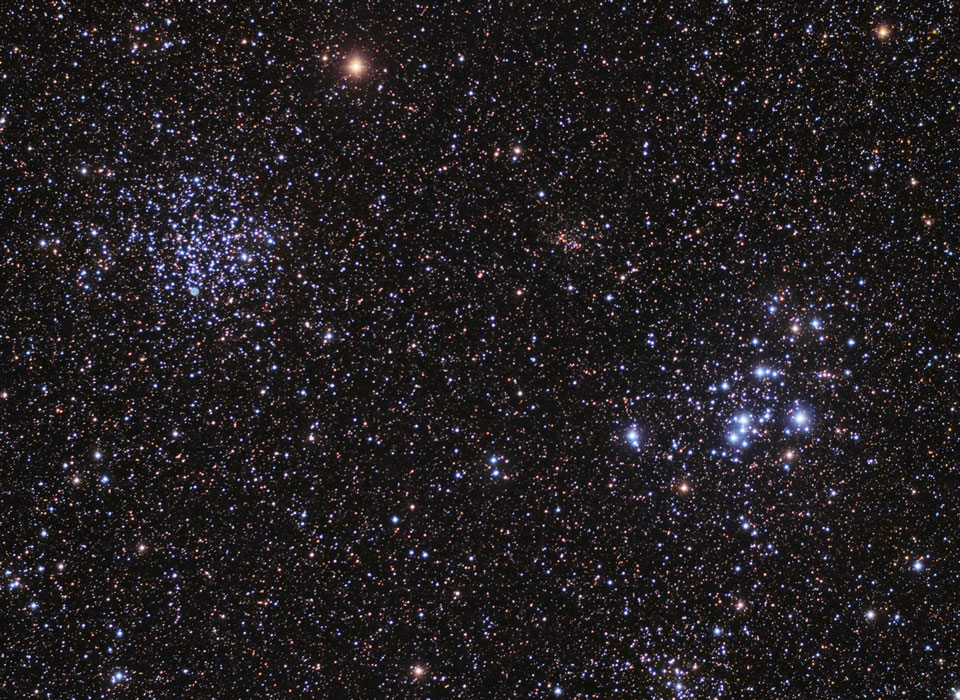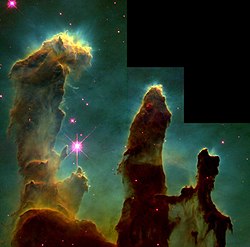Of Course A Rainbow Sky!!!!
Hi Everybody!! Welcome and please come in. We will be starting at my magic moons and jumping off into deep space to go visit the Hubble Telescope in search of Nebula!! It is going to be a 'Spacey' night, so prepare to be spaced out! Thank You for choosing to come in the Blog mini-Nature Class and for coming back!! We hit 9500 page reads this morning. (You can see the page count at the bottom if you follow that stuff).
These are my magic moons we are passing through. These are real images of the moon I shot 2 nights ago. The reality stops there. The remaining sky is created by me! I go to my online editing software place named Picnik and Snap, presto, like magic; I transform the original image!! I want to encourage all of You to play around with your images in the different programs. It is fun and I like it. These moons have an effect added to them called Space Textures. Like the Challenger, these Space Textures are Going Away forever on April 19, 2012. If you choose to try out some of these effects, you have about 2 weeks. Picnik is the name of the Program.
(Picnik is now gone)
Good bye to Picnik, Thanks for the Fun!!!!!!!
This last moon is the end of my fake space photos!
From here we will step into REAL SPACE PHOTOS by Hubble and all my friends at Space.com.
The images you will witness from here to the end of page are Real Places. These are Real Images. Many, many people have invested their time to Map the Universe based on the Real Images from the fantastic telescope, Hubble. They look more like fantasy, than fantasy, but remember this is Real Space, documented.
I have put alot of information videos on this page. Remember if you can not see it all at once, you may come back at any time to view any page again. The Blog will always be 'Live".
Enjoy this tour of Deep Space. It is my favorite trip so far!!
These Are Real Space Photos:
Soul Nebula's Heart Caught on CameraCredit: NASA/JPL-Caltech/WISE TeamNASA's WISE infrared space observatory mission team released this mosaic of the Soul Nebula (a.k.a. the Embryo Nebula, IC 1848, or W5) on April 2, 2010. The Soul Nebula is an open cluster of stars surrounded by a cloud of dust and gas over 150 light-years across and located about 6,500 light-years from Earth in the constellation Cassiopeia, near the Heart Nebula. http://www.space.com/12605-50-deep-space-nebula-photos.html
Astronomy Picture of the Day
2012 April 3

Image Credit & Copyright: Sergio Eguivar (Buenos Aires Skies
Explanation: Many stars form in clusters. Galactic or open star clusters are relatively young swarms of bright stars born together near the plane of our Milky Way Galaxy. Separated by about a degree on the sky, two nice examples are M46 (upper left) 5,400 light-years in the distance and M47 (lower right) only 1,600 light-years away toward the nautical constellation Puppis. Around 300 million years young M46 contains a few hundred stars in a region about 30 light-years across. Aged 80 million years, M47 is a smaller but looser cluster of about 50 stars spanning 10 light-years. But this portrait of stellar youth also contains an ancient interloper. The small, colorful patch of glowing gas in M46 is actually the planetary nebula NGC 2438 - the final phase in the life of a sun-like star billions of years old. NGC 2438 is estimated to be only 3,000 light-years distant and likely represents a foreground object, only by chance appearing along our line of sight to youthful M46. http://apod.nasa.gov/apod/ap120403.html
just push play
just push play
Reference sites to check out:
http://en.wikipedia.org/wiki/Hubble_Space_Telescope
http://en.wikipedia.org/wiki/Edwin_Hubble

Latest Saturn Photos From NASA's Cassini OrbiterCredit: NASA/JPL
just push play
http://en.wikipedia.org/wiki/Nebula
Nebula
From Wikipedia, the free encyclopedia
"Nebulae" redirects here. For the supercomputer in China, see Nebulae (computer). For other uses, see Nebula (disambiguation).
A nebula (from Latin: "cloud";[1] pl. nebulae or nebulæ, with ligature or nebulas) is an interstellar cloudof dust, hydrogen, helium and other ionized gases. Originally, nebula was a general name for any extended astronomical object, including galaxies beyond the Milky Way (some examples of the older usage survive; for example, the Andromeda Galaxy was referred to as the Andromeda Nebula before galaxies were discovered by Edwin Hubble). Nebulae are often star-forming regions, such as in the Eagle Nebula. This nebula is depicted in one of NASA's most famous images, the "Pillars of Creation". In these regions the formations of gas, dust, and other materials "clump" together to form larger masses, which attract further matter, and eventually will become massive enough to form stars. The remaining materials are then believed to form planets, and other planetary system objects
.
.

I reshared this on G+:
brendasue watson - Feb 14, 2012 - Public
The Rosette Nebula
The Rosette Nebula is not the only cosmic cloud of gas and dust to evoke the imagery of flowers -- but it is the most famous. At the edge of a large molecular cloud in Monoceros, some 5,000 light years away, the petals of this rose are actually a stellar nursery whose lovely, symmetric shape is sculpted by the winds and radiation from its central cluster of hot young stars. The stars in the energetic cluster, cataloged as NGC 2244, are only a few million years old, while the central cavity in the Rosette Nebula, cataloged as NGC 2237, is about 50 light-years in diameter. The nebula can be seen firsthand with a small telescope toward the constellation of the Unicorn (Monoceros).
Image Credit & Copyright: Brian Davis
Explanation of the image from: http://apod.nasa.gov/apod/ap120214.html
The Rosette Nebula is not the only cosmic cloud of gas and dust to evoke the imagery of flowers -- but it is the most famous. At the edge of a large molecular cloud in Monoceros, some 5,000 light years away, the petals of this rose are actually a stellar nursery whose lovely, symmetric shape is sculpted by the winds and radiation from its central cluster of hot young stars. The stars in the energetic cluster, cataloged as NGC 2244, are only a few million years old, while the central cavity in the Rosette Nebula, cataloged as NGC 2237, is about 50 light-years in diameter. The nebula can be seen firsthand with a small telescope toward the constellation of the Unicorn (Monoceros).
Image Credit & Copyright: Brian Davis
Explanation of the image from: http://apod.nasa.gov/apod/ap120214.html
More photos from Universe
Image Credit & Copyright: Brian Davis
Explanation: The Rosette Nebula is not the only cosmic cloud of gas and dust to evoke the imagery of flowers -- but it is the most famous. At the edge of a large molecular cloud in Monoceros, some 5,000 light years away, the petals of this rose are actually a stellar nursery whose lovely, symmetric shape is sculpted by the winds and radiation from its central cluster of hot young stars. The stars in the energetic cluster, cataloged as NGC 2244, are only a few million years old, while the central cavity in the Rosette Nebula, cataloged as NGC 2237, is about 50 light-years in diameter. The nebula can be seen firsthand with a small telescope toward the constellation of the Unicorn (Monoceros).

Nebula by StarlightCredit: Canada-France-Hawaii Telescope/CoelumSmall dust particles in this thin yet gigantic molecular cloud effectively scatter the starlight from surrounding giant blue stars in Orion, especially Rigel, causing the blue glow of reflection nebula IC 2118.

The Universe in Infrared: Flood of Galaxy Views to Hit Internet This YearCredit: G. J. Bendo/JBCA/NASAThe general public will be able to browse detailed infrared images of more than 200 galaxies from NASA's Spitzer Space Telescope later this year when they are publicly released.

Two Nebulas Glow Together in Stunning Skywatcher PhotoCredit: Bob and Janice FeraTwo colorful nebulas shine side by side in this skywatching image. Astrophotography duo Bob and Janice Fera took this photo in January, 2012 from Eagle Ridge Observatory, Foresthill, Calif.
http://hubblesite.org/gallery/

New Milky Way Photo Captures 1 Billion StarsCredit: Mike Read (WFAU), UKIDSS/GPS and VVVA new photo shows one billion of the Milky Way's stars at once

Delivering the GoodsCredit: ESA/S. CorvajaOn Friday March 23, 2012, an Ariane 5 VA205 rocket carrying the third Automated Transfer Vehicle, named Edoardo Amaldi, lifted off from Europe's spaceport in French Guiana. The ATV-3, as it is called, will ferry cargo to the International Space Station. The unmanned ATV-3 transports the heaviest load of cargo ever delivered to the station by a robotic spacecraft, the ESA reported.
just push play

Robonaut 2 and Gloved Astronaut's HandsCredit: NASAThe International Space Station's first humanoid robot pays homage to Michaelangelo in a photo tribute to the ceiling of the Sistine Chapel.

Amazing Nebula Photo Looks Like a Giant Human HeadCredit: NASA/JPL-CaltechA spectacular photo from a NASA telescope has revealed a wispy blue nebula with an odd twist: It looks like a giant human head in deep space.
just push play
just push play
Have great Dreams Tonight!!....this is brendasue signing off from Rainbow Creek
O+O










No comments:
Post a Comment
Hi Everybody! Please say hello and follow so I know you are here! Due to the inconsideration of people trying to put commercials on my blog comment area, I have restricted use of anonymous posts. Sorry that some hurt all.
My public email is katescabin@gmail.com No spammers or trolls